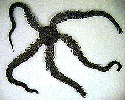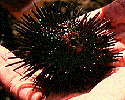Spiny Skinned Animals and Chordates
Be sure to write about what you are learning in the lab section of your notebook. You will be expected to answer questions about the lab activity during the lab self test and lab quiz. It helps to have your text and coloring books open beside you for support.
| Refer to the Assigned Readings Below: | |
| Marine Biology Textbook | Chapter 7, pages 142 to 147 |
| Marine Biology Coloring Book | Plates 39 to 42 |
|
Phylum
Echinodermata (spiny skin animals): Sea Stars, Brittle Stars, Feather
Stars, Sea Urchins, Sand Dollars, and Sea Cucumbers
|
||
|
1.
Sea stars, like many other echinoderms, have radial symmetry with
arms arranged in a circle around a central disc.
|
||
|
2. The ambulacral grooves of the arms contain tube feet, which are tiny suckers used in locomotion. |
||
|
3. Sea stars are usually carnivorous predators using their suckers to capture and manipulate prey. |
||
|
4. The arms of a brittle star are flexible, narrow, and emerge abruptly from the central body disc. |
||
|
5. A brittle star is able to violently contract the muscles in its arms severing portions when trapped. This defense mechanism, called autotomy, allows the star to escape the grasp of an enemy. |
||
|
6. Brittle stars are the fastest echinoderms. They move their arms in a rowing motion that propels them along. |
||
|
7. Crinoids have feather-like arms radiating from a stalk-like body called the calyx. |
||
|
8. Feather stars lack the long stalks of their relatives the sea lilies. |
||
|
9. Crinoids orient themselves with their oral side facing up. |
||
|
10. The skeletal plates of an urchin are tightly joined to form a rigid skeleton called a test. |
||
|
11. The body of an urchin is covered with spines. |
||
|
12. Sand dollars are urchins whose bodies are flat and whose spines are small. |
||
|
13. Sea cucumbers lack arms and have bodies that are stretched out along the oral-anal axis. |
||
|
14. Sea cucumbers have thick, leathery bodies that are worm-like and flexible. |
||
|
15. The long, tentacular, oral tube feet that surround the mouth of a sea cucumber are used to collect food. |
||
|
Phylum
Chordata (notocord animals): Tunicates, Sea Lancelets,
and Vertebrates
|
||
|
1.
Sea squirts are filter feeders that create a water current that
passes through their pharynx. Food particles are filtered from the
water current, entangled in a strand of mucous, and passed into
the stomach.
|
||
|
2. Sea squirts are also called tunicates, a reference to their cellulose covering, called the tunic. |
||
|
3. Although adult tunicates are attached to the bottom, they produce free-swimming tadpole larvae that look like little fish. |
||
|
4. The bodies of cephalochordates, like Amphioxus, are fish-like and pointed at both ends. |
||
|
5. The muscles of Amphioxus' body are arranged into V-shaped segments called myomeres that act upon a stiff but flexible rod called the notocord. |
||
|
6. Sea lancelets, like sea squirts, are filter feeders that use their ciliated pharynx to capture food particles. |
||
| Lab Activity 4.3 Molluscs and Jointed Legged Animals |















